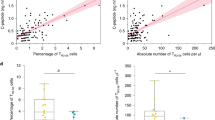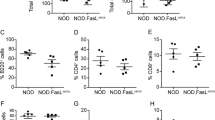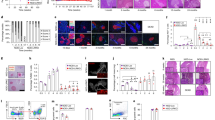Abstract
The predisposition of nonobese diabetic (NOD) mice to develop autoimmune disease is usually attributed to defects in peripheral tolerance mechanisms. Here, evidence is presented that NOD mice display a defect in central tolerance (negative selection) of thymocytes. Impaired central tolerance in NOD mice was most prominent in a population of semi-mature thymocytes found in the medulla. The defect was apparent in vivo as well as in vitro, was independent of IAβg7 expression and affected both Fas-dependent and Fas-independent pathways of apoptosis; for Fas-dependent apoptosis, the defective tolerance of NOD thymocytes correlated with the strong T cell receptor–mediated up-regulation of caspase 8–homologous FLICE (Fas-associated death-domain-like interleukin 1β–converting enzyme)-inhibitory protein. In light of these findings, disease onset in NOD mice may reflect defects in central as well as peripheral tolerance.
This is a preview of subscription content, access via your institution
Access options
Subscribe to this journal
Receive 12 print issues and online access
$209.00 per year
only $17.42 per issue
Buy this article
- Purchase on Springer Link
- Instant access to full article PDF
Prices may be subject to local taxes which are calculated during checkout






Similar content being viewed by others
References
Nossal, G. J. V. Negative selection of lymphocytes. Cell 76, 229–239 (1994).
Sprent, J. & Webb, S. R. Intrathymic and extrathymic clonal deletion of T cells. Curr. Opin. Immunol. 7, 196–205 (1995).
Amsen, D. & Kruisbeek, A. M. Thymocyte selection: not by TCR alone. Immunol. Rev. 165, 209–229 (1998).
Sebzda, E., Mariathasan, S., Ohteki, T., Jones, R., Bachmann, M. F. & Ohashi, P. S. Selection of the T cell repertoire. Annu. Rev. Immunol. 17, 829–874 (1999).
Kishimoto, H. & Sprent, J. The thymus and negative selection. Immunol. Res. 21, 315–323 (2000).
Izui, S., Ibnou-Zekri, N., Fossati-Jimack, L. & Iwamoto, M. Lessons from BXSB and related mouse models. Int. Rev. Immunol. 19, 447–472 (2000).
Kono, D. H. & Theofilopoulos, A. N. Genetics of systemic autoimmunity in mouse models of lupus. Int. Rev. Immunol. 19, 367–387 (2000).
Marrack, P., Kappler, J. & Kotzin, B. L. Autoimmune disease: why and where it occurs. Nature Med. 7, 899–905 (2001).
Makino, S. et al. Breeding of a non-obese, diabetic strain of mice. Jikken Dobutsu 29, 1–13 (1980).
Wicker, L. S., Todd, J. A. & Peterson, L. B. Genetic control of autoimmune diabetes in the NOD mouse. Annu. Rev. Immunol. 13, 179–200 (1995).
Delovitch, T. L. & Singh, B. The nonobese diabetic mouse as a model of autoimmune diabetes: immune dysregulation gets the NOD. Immunity 7, 727–738 (1997).
Rapoport, M. J. et al. Interleukin 4 reverses T cell proliferative unresponsiveness and prevents the onset of diabetes in nonobese diabetic mice. J. Exp. Med. 178, 87–99 (1993).
Cameron, M. J. et al. IL-4 prevents insulitis and insulin-dependent diabetes mellitus in nonobese diabetic mice by potentiation of regulatory T helper-2 cell function. J. Immunol. 159, 4686–4692 (1997).
Cameron, M. J., Arreaza, G. A. & Delovitch, T. L. Cytokine- and costimulation-mediated therapy of IDDM. Crit. Rev. Immunol. 17, 537–544 (1997).
Gombert, J. M. et al. IL-7 reverses NK1+ T cell-defective IL-4 production in the non-obese diabetic mouse. Int. Immunol. 8, 1751–1758 (1996).
Gombert, J. M. et al. Early quantitative and functional deficiency of NK+-like thymocytes in the NOD mice. Eur. J. Immunol. 26, 2989–2998 (1996).
Serreze, D. V. & Leiter, E. H. Defective activation of T suppressor cell function in nonobese diabetic mice. Potential relation to cytokine deficiencies. J. Immunol. 140, 3801–3807 (1988).
Arreaza, G. A. et al. Neonatal activation of CD28 signaling overcomes T cell anergy and prevents autoimmune diabetes by an IL-4 dependent mechanism. J. Clin. Invest. 100, 8670–8674 (1997).
Colucci, F., Bergman, M. L., Penha-Goncalves, C., Cilio, C. M. & Holmberg, D. Apoptosis resistance of nonobese diabetic peripheral lymphocytes linked to the Idd5 diabetes susceptibility region. Proc. Natl Acad. Sci. USA 94, 8670–8674 (1997).
Rapoport, M. J., Lazarus, A. H., Jaramillo, A., Speck, E. & Delovitch, T. L. Thymic T cell anergy in autoimmune nonobese diabetic mice is mediated by deficient T cell receptor regulation of the pathway of p21ras activation. J. Exp. Med. 177, 1221–1226 (1993).
Salojin, K. et al. Impaired plasma membrane targeting of Grb2-murine son of sevenless (mSOS) complex and differential activation of the Fyn-T cell receptor (TCR)-ζ-Cbl pathway mediate T cell hyporesponsiveness in autoimmune nonobese diabetic mice. J. Exp. Med. 186, 887–897 (1997).
Tisch, R. & McDevitt, H. O. Insulin-dependent diabetes mellitus. Cell 85, 291–297 (1996).
McDevitt, H. O. & Wakeland, E. K. Autoimmunity. Curr. Opin. Immunol. 10, 647–648 (1998).
Ridgway, W. M., Fasso, M. & Fasthman, C. G. A new look at MHC and autoimmune diabetes. Science 284, 749–751 (1999).
Ridgway, W. M. & Fathman, C. G. MHC structure and autoimmune T cell repertoire development. Curr. Opin. Immunol. 11, 638–642 (1999).
Kanagawa, O., Vaupel, B. A., Xu, G., Unanue, E. R. & Katz, J. D. Thymic positive selection and peripheral activation of islet antigen-specific T cells: separation of two diabetogenic steps by an I-A(g7) class II MHC β-chain mutant. J. Immunol. 161, 4489–4492 (1998).
Wicker, L. S., DeLarato, N. H., Pressey, A. & Peterson, L. B. Genetic control of diabetes and insulitis in the nonobese diabetic mouse: analysis of the NOD.H-2b and B10.H-2nod strains. in Molecular Mechanisms of Immunological Self-recognition (eds Alt, F.W. & Vogel, V.J.) 173–181 (Academic Press, New York, 1993).
Wicker, L. S. Major histocompatibility complex-linked control of autoimmunity. J. Exp. Med. 186, 973–975 (1997).
Kishimoto, H. & Sprent, J. Negative selection in the thymus includes semimature T cells. J. Exp. Med. 185, 263–271 (1997).
Kishimoto, H., Surh, C. D. & Sprent, J. A role for Fas in negative selection of thymocytes in vivo. J. Exp. Med. 187, 1427–1438 (1998).
Kishimoto, H. & Sprent, J. Several different cell surface molecules control negative selection of medullary thymocytes. J. Exp. Med. 190, 65–73 (1999).
Baldwin, A. S. Jr. The NF-κB and I-κB proteins. Annu. Rev. Immunol. 14, 649–684 (1996).
Van Antwerp, D. J., Martin, S. J., Kafri, T., Green, D. R. & Verma, I. M. Suppression of TNF-α-induced apoptosis by NF-κB. Science 274, 786–789 (1996).
Page, D. M., Roberts, E. M., Peschon, J. J. & Hedrick, S. M. TNF receptor-deficient mice reveal striking differences between several models of thymocyte negative selection. J. Immunol. 160, 120–133 (1998).
Punt, J. A., Havran, W., Abe, R., Sarin, A. & Singer, A. T cell receptor (TCR)-induced death of immature CD4+8+ thymocytes by two distinct mechanisms differing in their requirement for CD28 costimulation: implications for negative selection in the thymus. J. Exp. Med. 186, 1911–1922 (1997).
Punt, J. A., Osborne, B. A., Takahama, Y., Sharrow, S. O. & Singer, A. Negative selection of CD4+CD8+ thymocytes by T cell receptor-induced apoptosis requires a costimulatory signal that can be provided by CD28. J. Exp. Med. 179, 709–713 (1994).
Jondal, M., Okret, S. & McConkey, D. Killing of immature CD4+CD8+ thymocytes in vivo by anti-CD3 or 5′-(N-ethyl)-carboxamide adenosine is blocked by glucocorticoid receptor antagonist RU-486. Eur. J. Immunol. 23, 1246–1250 (1993).
Xue, Y. et al. Inhibition of I-Ad-, but not Db-restricted peptide-induced thymic apoptosis by glucocorticoid receptor antagonist RU486 in T cell receptor transgenic mice. Eur. J. Immunol. 26, 428–434 (1996).
Martin, S. & Bevan, M. J. Antigen-specific and nonspecific deletion of immature cortical thymocytes caused by antigen injection. Eur. J. Immunol. 27, 2726–2736 (1997).
Radons, J., Burkart, V. & Kolb, H. MHC class II-dependent abnormal reactivity toward bacterial superantigens in immune cells of NOD mice. Diabetes 46, 379–385 (1997).
Irmler, M., Hofmann, K., Vaux, D. & Tschopp, J. Direct physical interaction between the Caenorhabditis elegans 'death proteins' CED-3 and CED-4. FEBS Lett. 406, 189–190 (1997).
Tschopp, J., Irmler, M. & Thome, M. Inhibition of fas death signals by FLIPs. Curr. Opin. Immunol. 10, 552–558 (1998).
Scaffidi, C., Schmitz, I., Krammer, P. H. & Peter, M. E. The role of c-FLIP in modulation of CD95-induced apoptosis. J. Biol. Chem. 274, 1541–1548 (1999).
Surh, C. D. & Sprent, J. T-cell apoptosis detected in situ during positive and negative selection in the thymus. Nature (Lond.) 372, 100–103 (1994).
Wisniewska, M., Stanczyk, M., Grzelakowska-Sztabert, B. & Kaminska, B. Nuclear factor of activated T cells (NFAT) is a possible target for dexamethasone in thymocyte apoptosis. Cell Biol. Internat. 21, 127–132 (1997).
Linette, G. P., Li, Y., Roth, K. & Korsmeyer, S. J. Cross talk between cell death and cell cycle progression: BCL-2 regulated NFAT-mediated activation. Proc. Natl Acad. Sci. USA 93, 9545–9552 (1996).
Boise, L. H. et al. bcl-x, a bcl-2-related gene that functions as a dominant regulator of apoptotic cell death. Cell 74, 597–608 (1993).
Ridgway, W. M., Fasso, M., Lanctot, A., Garvey, C. & Fathman, C. G. Braking self tolerance in nonobese diabetic mice. J. Exp. Med. 183, 1657–1662 (1996).
Tian, J., Gregori, S., Adorini, L. & Kaufman, D. L. The frequency of high avidity T cells determine the hierarchy of determinant spreading. J. Immunol. 166, 7144–7157 (2001).
Targoni, O. S., & Lehman, P. V. Endogenous myelin basic protein inactivates the high avidity T cell repertoire. J. Exp. Med. 187, 2055–2063 (1998).
Klein, L., Klugmann, M., Nave, K. A., Tuohy, V. K. & Kyewski, B. Shaping of the autoreactive T-cell repertoire by a splice variant of self protein expressed in thymic epithelial cells. Nature Med. 6, 56–61 (2000).
Anderson, A. C. et al. High frequency of autoreactive myelin proteolipid protein-specific T cells in the periphery of naïve mice: mechanisms of selection of the self-reactive repertoire. J. Exp. Med. 191, 761–770 (2000).
Bennet, S. T. et al. Susceptibility of human type 1 diabetes at IDDM2 is determined by tandem repeat variation at the insulin gene minisatellite locus. Nature Genet. 9, 284–292 (1995).
Vafiadis, P. et al. Insulin expression in human thymus is modulated by INSVNTR alleles at the IDDM2 locus. Nature Genet. 15, 289–292 (1997).
Varfolomeev, E. E. et al. Targeted disruption of the mouse Caspase 8 gene ablates cell death induction by the TNF receptors, Fas/Apo1, and DR3 and is lethal prenatally. Immunity 9, 267–276 (1998).
Hill, N. J. et al. NOD Idd5 locus controls insulitis and diabetes and overlaps the orthologous CTLA4/IDDM12 and NRAMP1 loci in humans. Diabetes 49, 1744–1747 (2000).
Schmidt, D., Verdaguer, J., Averill, N. & Santamaria, P. A mechanism for the major histocompatibility complex-linked resistance to autoimmunity. J. Exp. Med. 186, 1059–1075 (1997).
Laemmli, U. K. Cleavage of structural proteins during the assembly of the head of bacteriophage T4. Nature 227, 680–685 (1970).
Zhang, X., Sun, S., Hwang, I., Tough, D. F. & Sprent, J. Potent and selective stimulation of memory-phenotype CD8+ T cells in vivo by IL-15. Immunity 8, 591–599 (1998).
Acknowledgements
We thank B. Marchand for typing the manuscript and R. Salmon for assistance in developing the RT-PCR system for the FLIP gene. Supported by grants CA38355, AI21487, AI46710 and AG01743 from the United States Public Health Service.
Author information
Authors and Affiliations
Corresponding author
Rights and permissions
About this article
Cite this article
Kishimoto, H., Sprent, J. A defect in central tolerance in NOD mice. Nat Immunol 2, 1025–1031 (2001). https://doi.org/10.1038/ni726
Received:
Accepted:
Published:
Issue Date:
DOI: https://doi.org/10.1038/ni726
This article is cited by
-
Transplantation of MHC-mismatched mouse embryonic stem cell-derived thymic epithelial progenitors and MHC-matched bone marrow prevents autoimmune diabetes
Stem Cell Research & Therapy (2019)
-
Hydrophobic CDR3 residues promote the development of self-reactive T cells
Nature Immunology (2016)
-
Thymocyte development in the absence of matrix metalloproteinase-9/gelatinase B
Scientific Reports (2016)
-
Mechanisms of diabetic autoimmunity: II—Is diabetes a central or peripheral disorder of effector and regulatory cells?
Immunologic Research (2016)
-
Mechanisms of diabetic autoimmunity: I—the inductive interface between islets and the immune system at onset of inflammation
Immunologic Research (2016)



